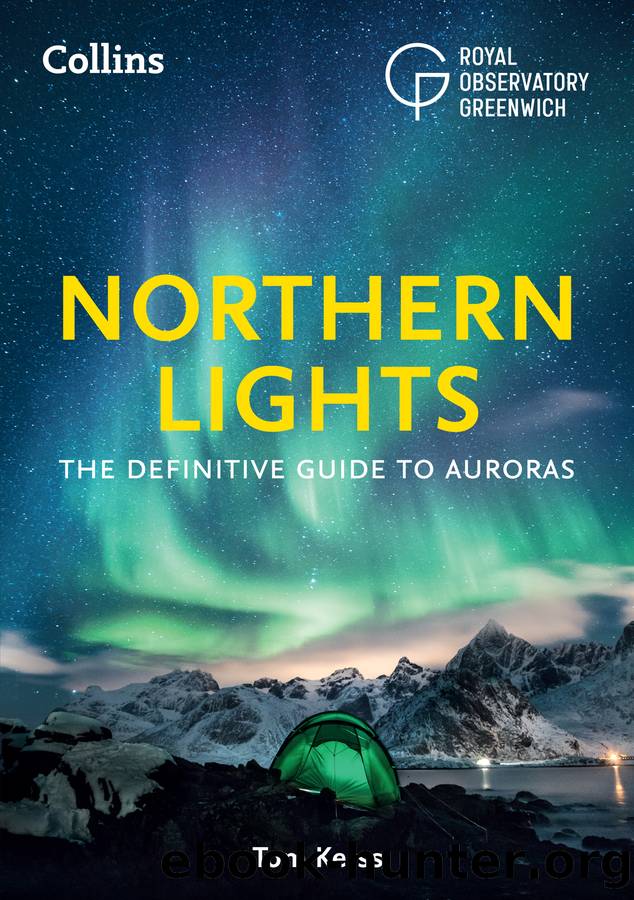The Northern Lights by Tom Kerss

Author:Tom Kerss [Kerss, Tom]
Language: eng
Format: epub
Publisher: HarperCollins Publishers
Published: 2021-09-15T00:00:00+00:00
Powerful geomagnetic storms pose indirect risks to us. They induce strong currents in the ground, which are readily conveyed by cables forming our electrical grids. Huge surges can saturate the cores of transformers and possibly destroy them. On a large enough scale, a sufficiently intense event could deprive many millions of people of electricity for a long time. In practice, this has not been tested, because the largest storms (or superstorms) on record occurred before we became so reliant on electrical infrastructure. Storms also threaten satellites and their communications. For example, the increased number of high-energy particles raise the risk of hardware or software errors as some of them penetrate the spacecraft shielding and strike microchips. As components have miniaturised through technological advancement, the relative effect of high-energy particle strikes has grown. Alternatively, the flurry of ions striking a spacecraft can differentially charge its surface (or components) until electrical discharges arc through them, causing potential damage. The Global Navigation Satellite System (GNSS) and Global Position System (GPS) satellite constellations are prone to signal errors during geomagnetic storms. Sudden changes in the density of the ionosphere affect signal propagation making them appear to twinkle as stars do to the eye. Several approaches to compensate have been developed, but both global position and communications remain sensitive to the space weather environment. A far more visible risk is heating of the upper atmosphere, which occurs when UV auroras brighten. This causes the atmosphere to expand, increasing the drag factor on satellites in low Earth orbit, which causes them to fall back to Earth. In 1979, NASAâs Skylab space station re-entered the atmosphere prematurely due to this phenomenon. To keep large satellites, such as the International Space Station (ISS), at a safe orbital altitude, they must be periodically âboostedâ up with a rocket burn. Forecasting high geomagnetic activity allows us to minimise damage by temporarily disabling or disconnecting potentially vulnerable systems.
Storm-force auroras are an astonishing sight at polar latitudes
Download
This site does not store any files on its server. We only index and link to content provided by other sites. Please contact the content providers to delete copyright contents if any and email us, we'll remove relevant links or contents immediately.
Harry Potter and the Prisoner of Azkaban by Rowling J K(3077)
The Hogwarts Library Collection by J K Rowling(2801)
The Inheritance Games by Jennifer Lynn Barnes(2779)
The Tales of Beedle the Bard by J.k.rowling (eng)(2701)
Harry Potter and the Deathly Hallows by unknow(2659)
The Crown of Gilded Bones (Blood And Ash Series Book 3) by Jennifer L. Armentrout(2560)
Harry Potter e il Principe Mezzosangue (Italian edition of Harry Potter and the Half-Blood Prince) by J.K.Rowling(2486)
The Crown of Gilded Bones by Jennifer L. Armentrout(2330)
Echo by Seven Rue(2194)
Iron Widow by Xiran Jay Zhao(2057)
Kingdom of the Wicked by Kerri Maniscalco(2015)
These Violent Delights by Chloe Gong(1917)
The Hawthorne Legacy by Jennifer Lynn Barnes(1680)
The Lost Book of the White (The Eldest Curses) by Cassandra Clare & Wesley Chu(1616)
The Girl and the Mountain by Mark Lawrence(1615)
Dark Deception by Rina Kent(1507)
Cemetery Boys by Aiden Thomas(1489)
Fable: A Novel by Adrienne Young(1430)
Iron Heart by Nina Varela(1404)
